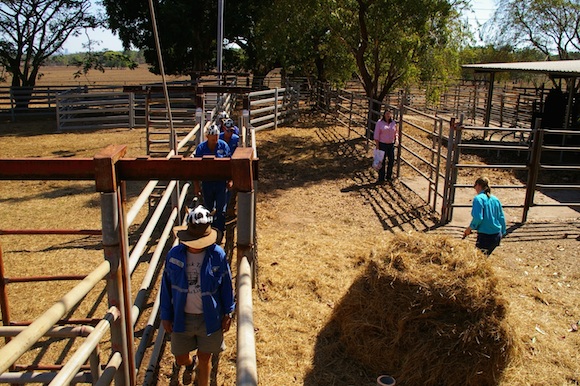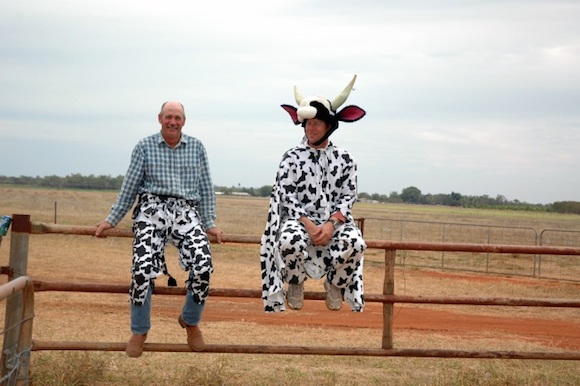Extension for truck drivers, does that mean adding another trailer to the road train?
Host: Katherine Research Station
Written by Trudi Oxley – Regional Manager, Katherine Pastoral Production.
This week the Katherine Pastoral Production crew from the NT Department of Primary Industries and Fisheries (DPIF) will give a snapshot of some of the many and varied activities we undertake to deliver research and extension. This year we also have a special correspondent from the Barkly, Helen, who will introduce herself later in the week. I will kick things off with telling you a bit about some of the training activities that we are involved in. Developing products that capture the research data combined with on ground experience and making it available for industry is a topic that is very close to my heart, it’s probably been the thing I have spent the most time doing whilst I have been working with the department as an extension officer for the last 14 or so years.
So, what exactly does being an extension officer involve? No, nothing to do with construction or adding rooms onto buildings. I guess you could say it’s a bit like being an information broker, we take research data, local producer experience and knowledge (and sometimes our own!), and try to package it up in ways that make sense to our clients, or assist producers to test it for themselves. Sometimes that involves yarning over a kitchen table, or collecting data in the yards, paddock, or office. Sometimes it involves a group of producers getting together on a property to check out a demonstration site, or in a classroom in the big smoke of somewhere like Katherine or Tennant Creek! Increasingly, there are options to use technology such as social media and webinars which can deliver information at the time of a producer’s choosing! The best part of the job is definitely getting to learn from the experience of all sorts of people in the industry, and debate and test how best to put the science to work on property or at others stages in the supply chain.
This week, for example my jobs will include; visiting a producer who participated in a major research trial, “Cashcow” (nothing to do with the Sunrise television show) to compare the economic response of strategies aimed at lifting reproductive performance. I will also be undertaking planning and organising for field days such as the “Breeding Polled cattle” field day, (Trish will tell you more about that tomorrow) and the major Kidman Springs Field day which we will hold in August – not to mention contributing to this great blog.
What I am doing today however is delivering a one day course that is aimed at truck drivers – the Northern Livestock Transporters course. The Katherine Pastoral Production mob, a number of commercial transport companies and the Katherine Pastoral Industry Advisory Committee teamed up a few years ago to develop an intensive short course for those involved in transporting livestock, which was funded by Meat and Livestock Australia and NT Department of Primary Industry and Fisheries. Transporters and producers alike could see that we were losing experienced drivers at a rate of knots and there were less and less people to mentor and instruct new operators, be they station truck drivers, or commercial company drivers.
 A station truck moving cattle on property and loading a boat at the wharf in Darwin, a really big ship can require up to 90 or so truckloads of cattle. The course is for station drivers and commercial drivers alike, or anyone involved in transporting cattle really!
A station truck moving cattle on property and loading a boat at the wharf in Darwin, a really big ship can require up to 90 or so truckloads of cattle. The course is for station drivers and commercial drivers alike, or anyone involved in transporting cattle really!
It is well accepted that the pre-transport management and transportation part of the supply chain is critical in many ways. If not managed well the producer can lose up to 10% or more of his total yearly income from cattle sales, and it is definitely the most visible part of the industry to the general public as the road trains travel across north Australia. Cattle lose weight through the process of mustering, drafting in the yards, and then in the truck during transport, we refer to this as “shrink”. Producers supplying the live export market are generally paid on the weight of the animal when it goes over the scale at the nearest weighbridge, so if you are 600km from town they could be travelling for much of a day, and the longer it takes and the more stressed the cattle are, the more weight they lose. It is recognised that undertaking this step of the chain is a partnership between producer and transporter – and the better our communication and understanding of how best to do the job, the better the welfare and production outcomes can be. One of the station managers who assisted us greatly in the development of the course said it well, “when we load out those trucks, the drivers are carrying our yearly paycheque, and how they do their job contributes to the size of that cheque”.
A part of the course is always to have a producer speaker give their perspective on the importance of the role of the transporter, and through the course of the day generally they are struck by some of the adverse conditions and situations drivers overcome, and how committed they are to improving the job they do.
Developing this course is one example of how we go about extension – we talked to drivers and producers from across the north about what topics were needed and what the best practice was. We then mixed in some of the science of animal behaviour and welfare as it applied to their day to day work, the impacts of transport and how it can be managed, safety, legislative requirements in terms of cattle health, movements and welfare, and then combined it all up into best practice training for the livestock transport industry.
The course is aimed at new drivers, but it is very much an interactive and discussion based day and we rely a lot on having experienced drivers attend also to share their knowledge. We have found it’s a good place for these conversations for a newcomer – away from the pressure of a big lift and the yards, where sometimes instructions can range from, well let’s say, brief to less than polite, about the fact that someone is in the wrong place or doing the wrong thing.
When there is no pressure on and we are in the relaxed environment of the workshop, it’s really quite amazing the tips and tools some of the experienced drivers have to share with the new fella’s – to both look after the cattle and keep the trucks rolling across some of the toughest conditions going. The “Outback Truckers” show on Discovery Channel has got nothin’ on some of the stories we have heard at these courses! Seriously, you could write a book. We always take a bit of a tally on the years of experience in the room in handling livestock and driving trucks, it’s not unusual to have a combined experience of over 300 years in both in the room! We have held these courses in Charters Towers, Cloncurry, Darwin, and Katherine for many and varied transport companies, and I (and the participants also they tell me . . .) have learned a heap about what to do and what not to when trucking cattle.
I can tell you it’s extremely nerve wracking to front up to a classroom of truckie’s who often may have years of experience and who are NOT used to sitting in a classroom. I have to say though; once we get going I have had nothing but positive experiences with these courses, and heaps of fun, as you can see by the image below. Participants are not afraid to get into the spirit of the day and, in order to improve the quality of the journey, have a crack at imagining how things might look from their passenger’s perspective . . .
 Course participants practicing loading techniques on each other to get a cows eye view of the situation!
Course participants practicing loading techniques on each other to get a cows eye view of the situation!
As a part of the teaching materials we also made some DVD clips to demonstrate stockhandling and safety techniques, we were particularly proud of our movie star cow . . . Nothing like a laugh to help you remember how not to get run over!
Doofus stockman shows us what NOT to do!
 We recruited some travelling Queenslanders to be the canvas cow, shown are front half Sean Chalmers and, ahem, rear end Jim Busicko who kindly volunteered to, sorry but I can’t help it, make an ass of himself!
We recruited some travelling Queenslanders to be the canvas cow, shown are front half Sean Chalmers and, ahem, rear end Jim Busicko who kindly volunteered to, sorry but I can’t help it, make an ass of himself!
We went to quite a lot of effort in filming the stockhandling scene’s, including getting a cherry picker to get some good “birds eye” shots. The DVD has proved really useful in demonstrating handling principles. Whilst you also need participants to have a go at handling the cattle using the techniques to develop a feel for it; the DVD is useful to show certain situations, as they say, never work with animals or children when you have an audience as something is bound to go pear shaped! When doing a live demo at a course you can never be assured of creating the exact scenario you are trying to demonstrate and it can all happen a bit too quick to call. With the DVD, you have the luxury of slow motion, pause, rewind, and those groovy white lines the cricket commentators use to illustrate winning shot angles and the like (not to mention delete ha ha!).
 We had to get up REALLY high to get birds eye shots of cattle on the top crate.
We had to get up REALLY high to get birds eye shots of cattle on the top crate.
 Trish, turning her hand to being a camera operator during DVD filming.
Trish, turning her hand to being a camera operator during DVD filming.
Actually, a funny story about Trish, when she was travelling through north Queensland collecting the input of drivers and cattle producers in the development of this course, a young fella tried to pick her up in Mt Isa one night -and instead of going for the old I’m an aeronautical engineer/chopper pilot/bullrider or the like, and without knowing the mission she was on, he actually used the opening line “I’m a livestock re-location technician” in the attempt to impress her – turned out he was truck driver! We thought that was hilarious, and appropriate, given the reason for the trip! We have been using this job title as an opening line in the course ever since – as it is a more apt description of the professional role of a driver these days, they are much more than just a steering wheel attendant.
So, back to today, I’d best get my “going out” double pluggers on and get amongst it- but hopefully you have seen why being involved in these workshops is just one of the many and varied reasons I love my job. It’s great to be part of an industry who, whilst we have some fun along the way, take the business of animal welfare, the safety of our people, and sustainable production with the utmost seriousness, attention, and pride.
Cheers
Trudi

